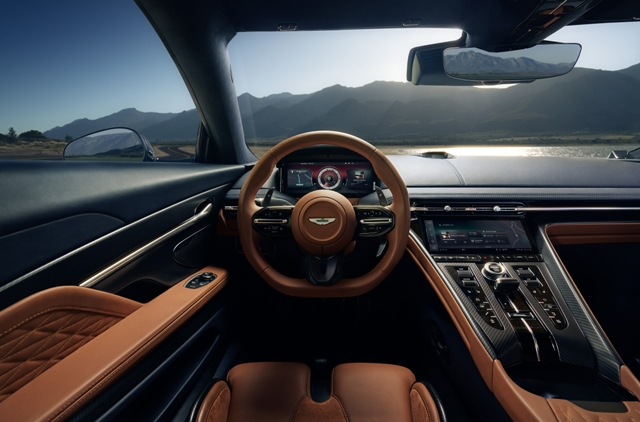
Aston Martin DB12: The world’s first Super Tourer
(Oilandgaspress) Aston Martin introduced the new DB12. Delivering a quantum shift in sporting character and dynamic capability, this new generation of the legendary DB bloodline defines its own new category. Combining a scintillating driving experience with exceptional refinement, state-of-the-art technology and indulgent luxury, the DB12 demands a new definition. Grand is not enough; this is the world’s first Super Tourer.
The DB12 takes a new direction. One which makes it the most complete and accomplished DB model in Aston Martin’s history. Blessed with exceptional performance and handling to satisfy and reward the most demanding drivers, its meticulously honed chassis is perfectly matched to a class-leading 680PS/800NM V8 Twin-Turbo powertrain. The result is an energised Aston Martin that shines with authenticity, capability and passion to deliver a driving experience that’s second to none.

Engineered to maximise performance and intensify emotion, the DB12 is the product of a holistic approach. One that starts with meaningful increases in structural stiffness and ends with Michelin Pilot Sport 5 S tyres made to Aston Martin’s precise specification. Supported by an all-new suspension system featuring the latest adaptive dampers, control and connection are further amplified by an exceptionally precise and direct Electronic Power Assisted Steering (EPAS) system and an Electronic Rear Differential (E-Diff) that enhances agility and brings the DB12 alive on the most dynamic of roads.
Supported by an industry leading Electronic Stability Control (ESC) system, which employs six-axis inertia measurement to predict available grip, the DB12 also gives the driver a choice of five pre-set driving modes allowing the freedom to incrementally explore the limits of grip and traction with complete confidence and safety. Put simply, no series production Aston Martin has dedicated itself so completely to setting new dynamic benchmarks.
The announcement of DB12 comes as Aston Martin celebrates two significant milestones in 2023; Its monumental 110th anniversary and 75 years of the illustrious DB model line. When founders Lionel Martin and Robert Bamford officially formed the partnership that became Aston Martin, they ignited more than a century of automotive passion, cutting-edge British innovation, and high-octane racing success. It comes at a time when Aston Martin is enjoying one of the most dynamic periods in its 110-year history thanks to continued podium success in the 2023 Formula 1® season. Competing at the pinnacle of world motorsport remains a key pillar of the marque’s brand and product strategy.
DB12’s core values of high-performance and ultra-luxury are spearheading Aston Martin’s next generation of sports cars. As such it heralds a new era. One which will see all Aston Martin models characterised by prodigious performance and pinpoint dynamics, seamless integration of advanced technologies and the sublime style and exemplary craftsmanship for which the brand has long been renowned.
Performance – fiercer, newfound engagement from class-leading powertrain
Unapologetic and unambiguous, DB12 makes an emphatic statement. One that exudes the confidence of a car endowed with a 0-60mph time of 3.5 seconds, a 202mph top speed and best-in-class potency from its 4.0 Twin-Turbo V8 engine. This exceptional hand-built engine, tuned by Aston Martin engineers to deliver class-leading 680PS/671bhp at 6000rpm and 800Nm/590lb ft between 2750-6000rpm; an increase of 34% compared with the outgoing DB11.
These higher outputs have been achieved through modified cam profiles, optimised compression ratios, larger diameter turbochargers, and increased cooling. To manage increased thermal demands the cooling system has been completely redesigned, with an additional two auxiliary coolers added to the existing central main radiator. To ensure desired engine intake air temperatures are achieved in all conditions, an additional low temperature radiator has been fitted to the charge cooler water circuit.
In addition, the auxiliary outboard engine oil cooler now has over double the face area of its predecessor in order to manage the demands on the lubrication circuit. Cooling has been optimised further by improving thermal airflow, a 56% increase in open apertures allowing more cold air to flow into the radiators, while centrally mounted bonnet vents placed above the twin turbos allow hot air to escape.
Handling and dynamics – the sharpest DB ever
Power is fed through an 8-speed automatic transmission and for the first time on an Aston Martin DB model, Electronic Rear Differential (E-Diff). This differential is linked to the car’s Electronic Stability Control (ESC) system. Unlike a conventional Limited Slip Differential, it can go from fully open to 100% locked in a matter of milliseconds, giving the driver maximum response for more precise and consistent handling.
Working in harmony with the latest generation ESC system the E-Diff significantly improves the car’s cornering capabilities in all conditions. In low to medium speed corners, the DB12 feels brilliantly agile and responsive, coming alive on challenging roads thanks to immense front-end grip and tremendous traction. Meanwhile, total composure in high-speed corners lends the DB12 to a great feeling of confidence and control.
To increase driver engagement and amplify the intensity of its performance, the DB12 features a revised (shortened) Final Drive Ratio (3.083:1), plus a unique transmission shift calibration. The former works to deliver punchier in-gear acceleration, while the latter reduces shift speeds and creates different shift characteristics to suit the DB12’s broad range of dynamic modes.
DB12’s bonded aluminium structure has seen a 7% increase in global tortional stiffness thanks to changes to a range of underbody components; the engine cross brace; front and rear undertrays; front crossmember and rear bulkhead. The combined effect is a focused improvement in tortional rigidity and lateral stiffness – especially between the front and rear strut towers – which provides a stronger and more stable attachment points for the dampers and rear axle. This brings gains in suspension performance, isolation and refinement, along with improvements in on and off-centre steering feel and overall sense of driver connection.
Information Source: Read More “
Energy Monitors , Electric Power , Natural Gas , Oil , Climate , Renewable , Wind , Transition , LPG , Solar , Electric , Biomass , Sustainability , Oil Price , Electric Vehicles,

